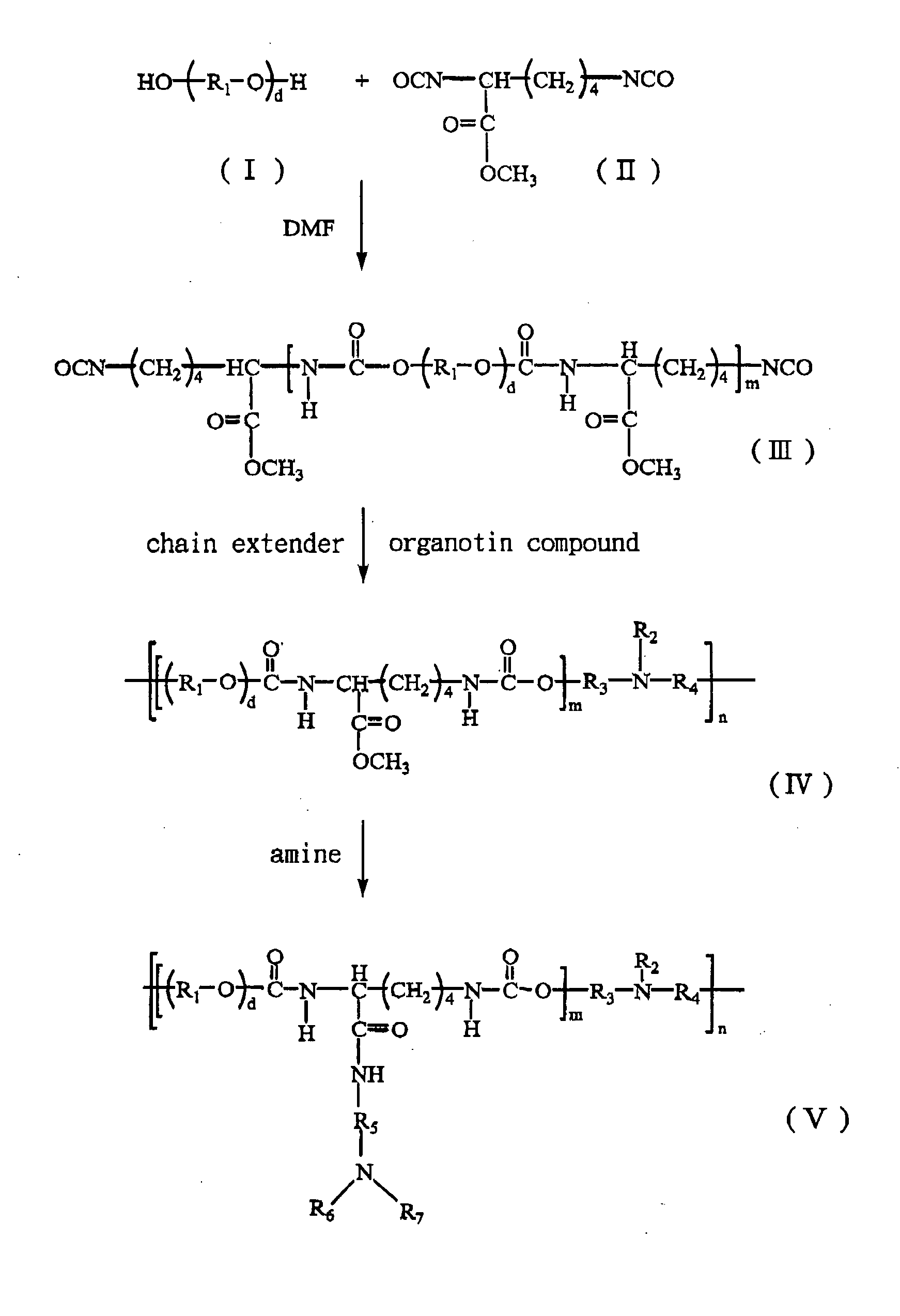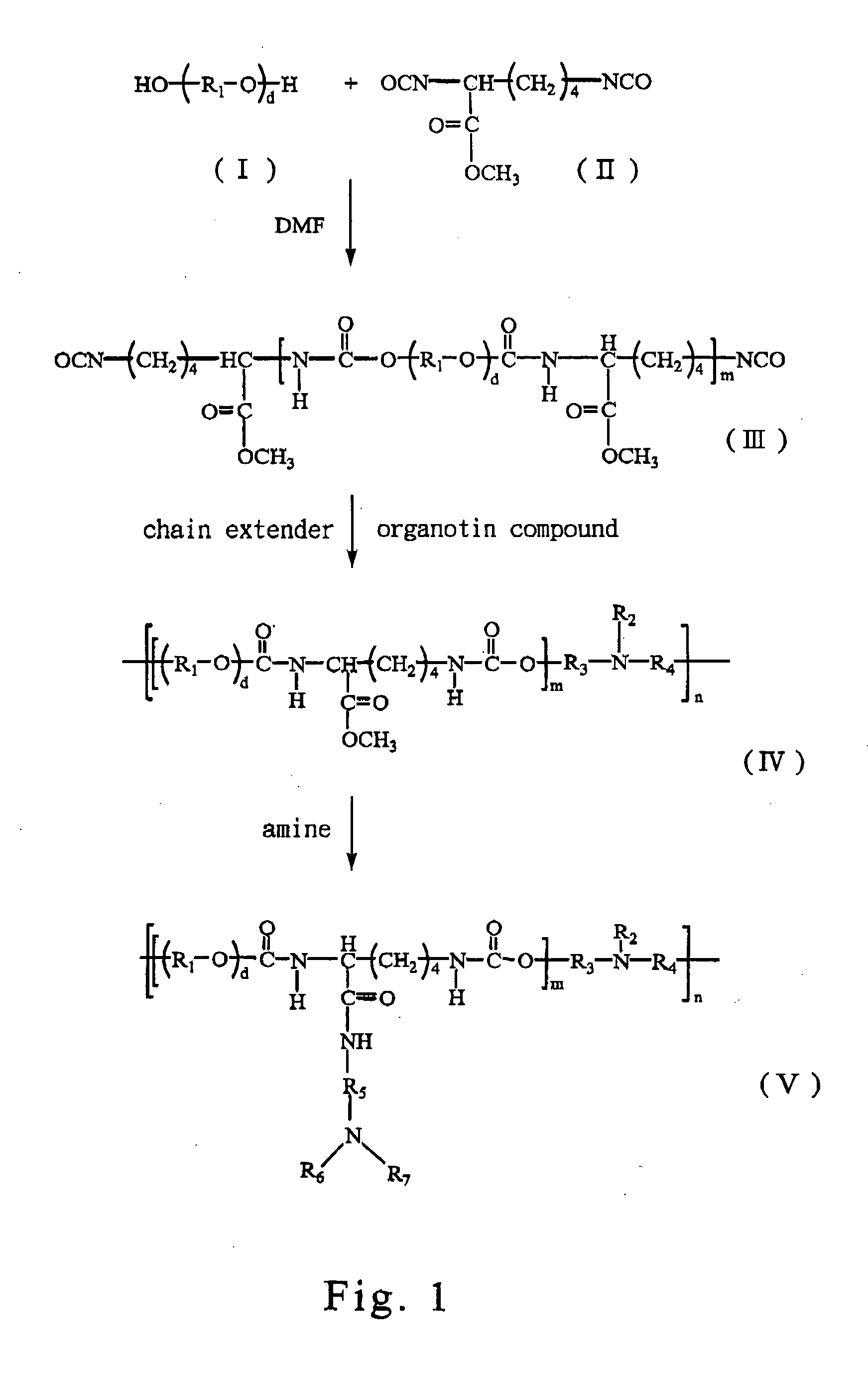Biodegradable cationic polymer
a cationic polymer and biodegradable technology, applied in the field of biodegradable cationic polymers, can solve the problems of insufficient therapy, insufficient risk, and insufficient treatment
- Summary
- Abstract
- Description
- Claims
- Application Information
AI Technical Summary
Problems solved by technology
Method used
Image
Examples
example 1
Synthesis of Prepolymer
[0103] Polymerizations are conducted in a three-necked reaction flask under dry nitrogen purge according to a standard two-step process well known in the art. LDI (II) (from Kyowa Hakko Kogyo Co., Ltd) and PEG 200 (I) (MW=200 g / mol, from Showa Co., Ltd) as shown in FIG. 1 are dried in a vacuum oven, then prepolymerized in anhydrous DMF at approximately 80° C. until 2 / 1 of NCO / OH molar ratio, to obtain an isocyanate-terminated prepolymer of the formula (III) in the FIG. 1. The NCO content is determined by di-n-butylamine titration during prepolymerization.
example 2
Synthesis of Polyurethane
[0104] The resulting prepolymer has decrease of 0 to 10° C., then a chain extension is carried out by adding MDEA slowly to the prepolymer until 1 / 1 of NCO / OH molar ratio, and using 0.5 wt % dibutyltin dilaurate as a catalyst at approximately 80° C. for approximately 120 min until the unreacted isocynate group is not observed, to obtain a polyurethane.
example 3
Synthesis of DEDA-PU
[0105] An aminolysis reaction is performed, which replaces the methyloxide group of the resulting polyurethane with DEDA. 100 g of the resulting polyurethane is dissolved in 1 liter of anhydrous DMF, then excess DEDA is slowly added into the DMF solution of polyurethane stirring at least for 48 hours. Under reduced pressure, the methyloxide group provided by LDI of the resulting polyurethane is replaced by DEDA to form DEDA-PU. The resulting DEDA-PU is precipitated in cold ethyl ether and then dried at 50° C. under vacuum.
[0106] The resulting DEDA-PU is characterized and analyzed with Fourier transform infrared (FT-IR) spectrometer (Perkin-Elmer 824) and nuclear magnetic resonance (NMR) spectrometer (Varian UnityInova 500-Hz). Reference is made in FIG. 2, which is an FT-IR spectrum of DEDA-PU according to one preferred embodiment of this invention. A strong absorption peak of the curve (a) of the polyurethane at 2250 cm−1, before polymerization, corresponding t...
PUM
| Property | Measurement | Unit |
|---|---|---|
| Temperature | aaaaa | aaaaa |
| Temperature | aaaaa | aaaaa |
| Temperature | aaaaa | aaaaa |
Abstract
Description
Claims
Application Information
 Login to View More
Login to View More - R&D
- Intellectual Property
- Life Sciences
- Materials
- Tech Scout
- Unparalleled Data Quality
- Higher Quality Content
- 60% Fewer Hallucinations
Browse by: Latest US Patents, China's latest patents, Technical Efficacy Thesaurus, Application Domain, Technology Topic, Popular Technical Reports.
© 2025 PatSnap. All rights reserved.Legal|Privacy policy|Modern Slavery Act Transparency Statement|Sitemap|About US| Contact US: help@patsnap.com



